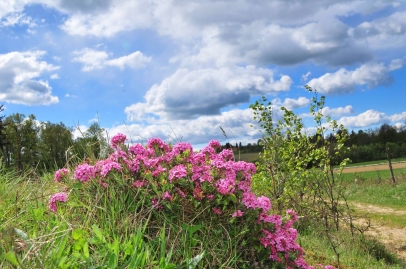Shrubby rose daphne
One of the greatest botanical specialties in Goričko is certainly the shrubby garland flower or shrubby rose daphne (Daphne cneorum f. arbusculoides). It is an endemic subspecies that thrives only in the area of north-eastern Slovenia, western Hungary, and south-eastern Austria, and is an interesting ecological adaptation for acidified non-carbonate soils, which is reflected in its (semi)shrubby growth. Until 1950 it was unknown even to the Slovenian botanists. In Slovenia, it thrives exclusively in the municipalities of Šalovci and Hodoš. The flowers of the shrubby rose daphne are also depicted on the coat of arms of the municipality of Šalovci.
It is up to 40 cm tall shrub, with overgrowths and often slightly deciduous stems, which are leafless in the lower parts. The dark green leaves are stripped and slightly leathery, as they are retained through the winter. Leaves grow from the stem in an alternating pattern. The blossoms are pink and distinctly fragrant, they are clustered together into inflorescences of up to 20 blossoms. The blossom is formed from four pink calyx leaves, which are fused into a tube. Fragrant pink blossoms can be admired between April and June, shrubs occasionally also bloom for a second time during the fall. The fruit is a fleshy, seedy yellowish nut. Fruits actually develop quite rarely.
Flowers have a nice scent ![]() M. Podletnik
M. Podletnik
It grows on a sunny and poorly sandy soil, often along the forest edges, on the edges of dry meadows and in roadside ditches. In Goričko there is about 30 known growing locations. Scattered habitats count from 2 to 10 shrubs. One of the most widely represented sites is in the management of the Nature Park Goričko. It does not grow south of the Murska Sobota-Hodoš railway line.
The whole plant is very toxic. Ingestion of 10 to 12 fruits is a life-threatening amount for the children. The mezerein is a toxin found in fruits and seedlings and can reach up to 22% concentration within these parts. Signs of poisoning include nausea, vomiting, convulsions, shock, numbness of the limbs, burning taste in the mouth, blood in the stool, kidney damage, blood vomiting, slower heartbeat, dizziness, thirst, and breathing difficulties.
The Latin name of the genus is derived from the ancient Greek myth of the god Apollo, who pursued the nymph Daphne in an attempt to seduce her. When she could no longer escape she called for the help of Zeus himself, so he turned her into a laurel shrub (Laurus nobilis). Daphnia from gr. Dafgh = laurel, because the garland flower has leafs very similar to laurel. Mezereum comes from the medieval pharmaceutical name for the mezereum (Mezereum germanicum). It was also called laurel-leafed garland, while the one with small leaves, like the ones that garland flower got, got called German laurel-leafed garland. Slovenian names for garland flower is dišeči volčin, it also gets nicknamed jožefica (Josephine) and dafnica (Daphne). Nemci call it Heideröschen, while Hungarians named it henye boroszlán. English also call it rose daphne, while French named it petit thymélée and daphnné cameleé. Italians call it Dafne odorosa and Croatians crveni uskolisni likovac.
Garland flower is threatened by inappropriate interventions on growth sites by procedures such as digging, cutting, tilling and mulching, which can permanently destroy growth site. Most exposed to these interventions are plants growing on the road edges. A particular problem is the overgrowth of habitats by wooden plants, which obscure shrubs of garland flower and eventually cause them to disappear.
Shrubby garland flower often grown on road edges ![]() M. Podletnik
M. Podletnik
Did you know that first plant to receive protective status in Slovenia happened in 1989? It was the species of Balkan daphne (Daphne blagayana), which got white blossoms and is a relative of the fragrant flower. In Goričko mezereum (Daphne mezereum) is also quite common. Elsewhere in Slovenia grow already mentioned Balkan daphne, as well as alpine daphne (Daphne alpine), spurge-laurel (Daphne laureola) and striated daphne (Daphne striata).










